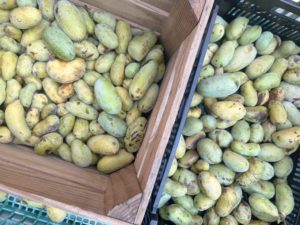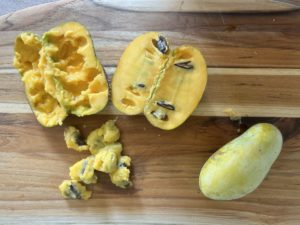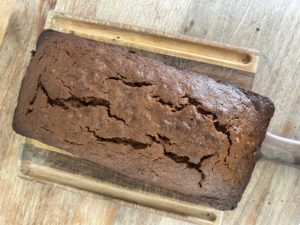Harvesting Pawpaw Fruit Trees at Shared Legacy Farms
This week, after Tuesday’s big thunderstorm, I took a stroll through our pawpaw orchard. As I walked, I couldn’t help but notice the ground was covered with fallen fruit. At first, I wondered, “Is it time already? Or was that just from the wind storm?” Sure enough, it’s pawpaw season!
What’s a Pawpaw?
For those who aren’t familiar, pawpaws are the largest edible fruit native to the United States. In fact, they are the official native state fruit of Ohio! (Fun fact, right?)
On the outside, a pawpaw resembles a green mango, but when you cut it open, you’ll find a soft yellow pulp inside, with a custard-like texture and a tropical flavor. It’s often described as a blend between banana and mango. While the pulp is delicious, pawpaws don’t have a long shelf life—just a few days. Be sure to enjoy them quickly!
Here’s what they look like:

Remember, only the pawpaw pulp is edible. The seeds, skin, leaves, and bark contain a neurotoxin, so be sure to avoid those parts.
From Orchard to Kitchen: Making Pawpaw Bread
After gathering some pawpaws, I scooped out the pulp from six fruits, which yielded about 1.5 cups. I decided to put it to good use and made a delicious pawpaw bread.
It’s hard to believe these trees were grafted by our friend Travis just five years ago. At the time, we weren’t sure what to expect, but this year, they are absolutely loaded with fruit! We’re thrilled to be able to share them with our farm community.

The pawpaw flesh is edible. Scoop out and discard the seeds. Most recipes require about 1.5 to 2 cups of pulp.
The Science Behind Pawpaw Trees
Pawpaw trees, scientifically known as Asimina triloba, are fascinating both in their growth habits and their unique pollination process. These trees are native to the eastern United States and have a natural affinity for the shady understory of forests, often thriving in moist, well-drained soils. However, they can also adapt to full sun conditions when grown in orchards, which can result in larger fruits.
Pawpaw trees are deciduous and can grow to heights of 15 to 30 feet. They develop a deep taproot early in their life, which can make them slow to establish above ground but resilient once mature. The trees also produce clonal offshoots from their root system, leading to the formation of pawpaw groves. However, these offshoots are genetically identical to the parent tree, which means they cannot cross-pollinate with each other.
One of the most intriguing aspects of pawpaw trees is their pollination strategy. The flowers are a deep maroon color and have a scent that is far from sweet—it’s more akin to something fermenting or rotting. This odor is actually beneficial for the tree, as it attracts the specific pollinators pawpaws rely on: flies and beetles. Unlike many other fruit trees that depend on bees for pollination, pawpaw flowers are designed to appeal to these less glamorous insects.
Despite the large number of flowers a pawpaw tree may produce, successful pollination is often limited. In the wild, it’s been observed that less than 1% of flowers result in fruit due to these pollination challenges. The trees are also “self-incompatible,” meaning they cannot self-pollinate. They require pollen from a genetically different tree to produce fruit, which is why having multiple varieties in close proximity, as you do in your orchard, is so important. Luckily, Travis grafted several different varieties in the same area of our orchard, which explains our bountiful harvest this year.

How to Use PawPaws
Due to its custard-like consistency, pawpaw is ideal for incorporating into a variety of recipes. You can use it to make quick breads, ice creams, puddings, smoothies, and even in savory dishes like sauces or chutneys. One of the most popular uses of pawpaw is in baking, where its natural sweetness and richness shine in muffins, cakes, and quick breads.
Here’s a simple pawpaw muffin recipe to get you started:
Pawpaw Muffins Recipe
Ingredients:
- 1 1/2 cups all-purpose flour
- 1/2 teaspoon baking soda
- 1/2 teaspoon baking powder
- 1/4 teaspoon salt
- 1/2 teaspoon cinnamon (optional)
- 1/2 cup sugar
- 1/4 cup melted butter or vegetable oil
- 1 cup pawpaw pulp (about 2-3 ripe pawpaws)
- 1 egg
- 1/2 teaspoon vanilla extract
- 1/4 cup milk (or as needed)
Instructions:
- Preheat your oven to 350°F (175°C) and line a muffin tin with paper liners.
- In a medium bowl, whisk together the flour, baking soda, baking powder, salt, and cinnamon.
- In a separate bowl, combine the sugar, melted butter, pawpaw pulp, egg, and vanilla extract until smooth.
- Gradually add the dry ingredients to the wet mixture, stirring just until combined. If the batter seems too thick, add a splash of milk to reach your desired consistency.
- Divide the batter evenly among the muffin cups.
- Bake for 18-22 minutes or until a toothpick inserted into the center of a muffin comes out clean.
- Allow the muffins to cool in the pan for 5 minutes before transferring them to a wire rack to cool completely.
Enjoy these muffins fresh, or freeze them for a quick breakfast option. The unique flavor of pawpaw adds a delightful twist to these simple treats!
